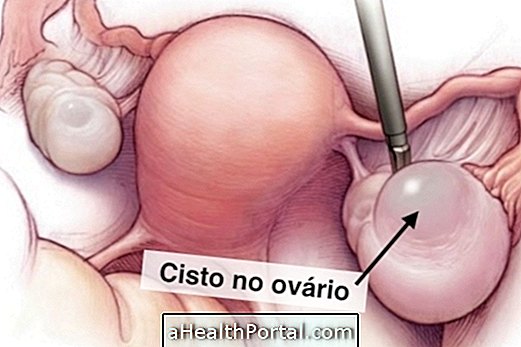Surgery is the main form of treatment to eliminate prostate cancer because, in most cases, it is possible to remove the entire malignant tumor and definitely cure the cancer, especially when the disease is still poorly developed and has not reached other organs.
This surgery, known as radical prostatectomy, is usually done in men under the age of 75, sexually active diagnosed with prostate cancer who do not yet have metastases. Although this treatment is essential, it may also be necessary to perform chemotherapy and radiation therapy after surgery to eliminate all malignant cells, complementing the treatment.
The tumor of the prostate is slow growing and therefore it is not necessary to perform the surgery immediately after discovering the adenocarcinoma, being able to wait a few days, without this increasing the risk of complications.

How is prostatectomy recovery?
Recovery is relatively rapid and rest is recommended only, avoiding exertion, for approximately 10 to 15 days. After that time, you can go back to day-to-day activities, such as driving or working, however, permission to work only occurs 90 days after the surgery. The intimate contact can be resumed after 40 days.
In the postoperative period of prostatectomy it is necessary to put a tube in the bladder, known as a bladder catheter, to be able to urinate because the urinary tract becomes very inflamed, preventing the passage of urine. This tube should be used for 1 to 2 weeks and should be withdrawn only after your doctor has told you to. Learn how to take care of the bladder catheter during this period.
In addition to surgery, chemotherapy and radiation therapy may be needed to kill malignant cells that have not been removed in surgery or have spread to other organs, preventing them from multiplying. See how all treatment options for prostate cancer work.
Possible consequences
In addition to the general risks, such as infection at the site of the scar or hemorrhage, surgery for prostate cancer may have other important sequelae such as:
1. Urinary incontinence
After surgery, the man may have some difficulty controlling the urine output, resulting in urinary incontinence. This incontinence can be mild or total and usually lasts between a few weeks or months after surgery.
This problem is more common in the elderly but can happen at any age depending on the degree of cancer development and type of surgery. Treatment usually begins with physiotherapy sessions, with pelvic exercises and small instruments such as biofeedback, and kinesiotherapy. In the most extreme cases, surgery can be performed to correct this dysfunction. See more details on how urinary incontinence treatment is done.
2. Sexual impotence
Sexual impotence is one of the most frequent and troubling complications for men because they can no longer initiate or maintain an erection. This is because together with the prostate there are important nerves that control the erection. Thus, impotence is more common in cases of highly developed cancer in which it is necessary to remove many affected areas and may need to remove the nerves.
In other cases, the erection may be affected only due to the inflammation of the tissues around the prostate that presses the nerves. Generally, these cases improve over the months or years as the tissues recover.
To help in the first few months, the urologist may recommend some remedies, such as Vardenafil or Sildenafil, which help to have a satisfactory erection. Learn more about treating impotence.
3. Retrograde ejaculation
This is one of the most common complications of surgery for prostate cancer and happens when the man does not eliminate sperm after intimate contact or masturbation. In these cases, the sperm is eliminated into the bladder and then eliminated in the urine.
Although this complication does not cause any health problem, it can decrease the fertility of the man and, therefore, treatment may be necessary, especially if the man wishes to have children. Understand how this problem is handled.
Surgery price
The value of surgery for the treatment of prostate cancer is approximately 15 thousand reais, but it can be made free of charge by the SUS as indicated by the urologist.
How is the surgery done

Surgery is done in most cases with general anesthesia, however it can also be done with spinal anesthesia that is applied to the back or just through a vein medication to sleep deeply. The surgery takes an average of 40 minutes to 1 hour and usually requires hospitalization for about 3 days.
Prostatectomy consists of removal of the prostate, including the prostatic urethra, seminal vesicles, and ampullae of the vas deferens, associated or not with bilateral lymphadenectomy.
Main techniques for performing surgery
To remove the prostate, surgery can be done by laparoscopy, that is, through small holes in the belly through which instruments to remove the prostate pass or by laparotomy where a greater cut is made in the skin. Thus, some techniques can be:
- Retropubic radical prostatectomy : In this technique, the doctor makes a small cut on the skin near the navel to remove the tumor from the prostate;
- Radical perineal prostatectomy : a cut is made between the anus and the scrotum and the tumor is removed. However, this technique is used less frequently than the previous one, since the nerves responsible for the erection are almost always affected, being able to cause impotence;
- Robotic radical prostatectomy : in this technique the doctor controls a machine with robotic arms and, therefore, the technique is more precise, with a lower risk of sequelae. However, it is a very rare and expensive technique;
- Transurethral resection of the prostate: It is usually performed in the treatment of benign prostatic hyperplasia, however, in the case of cancer it also helps alleviate some symptoms such as difficulty urinating.
In most cases, the most indicated technique is laparoscopy because it causes less pain, causes less blood loss and the recovery time is faster.
Exams and visits after surgery
After the prostate cancer treatment is completed, the PSA test is required every 6 months for 5 years. Bone densitometry and other imaging tests may also be performed annually to ensure that everything is OK, or to diagnose any change as early as possible.
The emotional system and the sexuality can be very shaken so it may be indicated to be followed by a psychologist during the treatment and in the first few months to follow. The support of family and close friends is also an important aid to proceed in tranquility.
Can cancer come back?
Yes, men diagnosed with prostate cancer have a higher risk of developing other cancers, such as rectum, leukemia, bowel or bladder, for example. That way it is advised to maintain healthy habits and not to smoke, in addition to performing diagnostic tests periodically, whenever requested by the doctor, because the sooner is diagnosed, the greater are your chances of cure.
























